 Sometimes a game doesn’t have to have the deepest (or any) theme to be enjoyable. While I don’t naturally gravitate towards these abstract games, every now and then I get sucked in by one that promises to be clever or unique. Recently, I’ve been hearing raves about Red7, a new card game published by Asmadi Games. Red7 seemed to be a fairly straight forward game, but what really got my attention was that it was designed by Carl Chudyk (Glory to Rome, Impulse), whose games I really enjoy. It’s probably because he’s a fan of “cards with multiple uses” like it am. So lets dive in and see what makes Red7 unique and if Carl has another hit on his hands.
Sometimes a game doesn’t have to have the deepest (or any) theme to be enjoyable. While I don’t naturally gravitate towards these abstract games, every now and then I get sucked in by one that promises to be clever or unique. Recently, I’ve been hearing raves about Red7, a new card game published by Asmadi Games. Red7 seemed to be a fairly straight forward game, but what really got my attention was that it was designed by Carl Chudyk (Glory to Rome, Impulse), whose games I really enjoy. It’s probably because he’s a fan of “cards with multiple uses” like it am. So lets dive in and see what makes Red7 unique and if Carl has another hit on his hands.
Red7 is a quick playing hand management and set collection game for 2-4 players. Red7 takes about 5-10 minutes to play and plays best with 3-4 players.
Game Overview:
The rules for Red7 are simple. At the end of your turn, you need to be winning or you are out. Normally I steer clear of player elimination games, but for a 5-10 minute game, I figured I’d give it a shot. Anyway, each player starts with a hand of 7 cards and each turn they will play cards to either add to their set or change how the game is won. If you aren’t winning at the end of your turn, you are eliminated. Last one left in the game is the winner.
Game Components:

There aren’t a whole lot to the components in this card game, but what’s here works. Red7 comes with 49 cards numbered 1-7, with each card being representing in one of the 7 colors of the rainbow. The card stock is of good quality and should hold up to repeated plays.
The art itself is fairly simple, mostly splashes of color, but the saturation levels make the deep color on the cards pleasant to look at. I should also note that each card is labeled with its number, color and win condition, so if you are color blind, you should still be able to play.
The rulebook is fairly small and contains rules for both a basic game and advanced. It also follows in the standard Carl Chudyk fashion, it’s not the easiest to learn from. There were some ambiguities with tie breakers that I ended up having to hop online to figure out. I just wasn’t completely clear how ties were resolved.
How to Play:
As mentioned above, there are basic rules and also advanced rules in Red7. I’ll just go over the basic rules here as I found them to be my favorite way to play.
To start, each player is dealt out a hand of 7 cards. On your turn, you can take one of the following 4 actions:
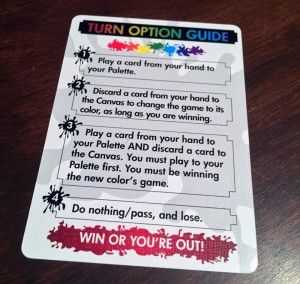
1. Play a card from your hand to your palette (the face-up cards in front of you).
2. Play a card from your hand to the canvas, changing the win condition. The canvas is shared by all players and there can only be 1 win condition at a time.
3. Play a card to your palette and the canvas.
4. Do nothing/pass. You lose.
Each color card has a different win condition. I won’t list them all out here, but they range from “highest card wins” to “most even cards” to “most cards below 4”. Overall there is a nice variety on win conditions.
If two players are tied in numerical value, then color becomes the tie breaker. So if the win condition is “most cards in a row” and 2 players both have a run of 2,3,4, then the player with the card highest in the spectrum wins the tie. So a red 7 card is basically a trump card that will win all ties its involved in.
If you can’t win at the end of your turn or are out of cards, you’re out of the game. The last player standing wins.
The rules for advanced play add a bit more strategy and variety to the game. These involve special actions, drawing extra cards and keeping score. This can provide some variations to the play if you want some more meat in the game, but to be honest, I found them all unnecessary.
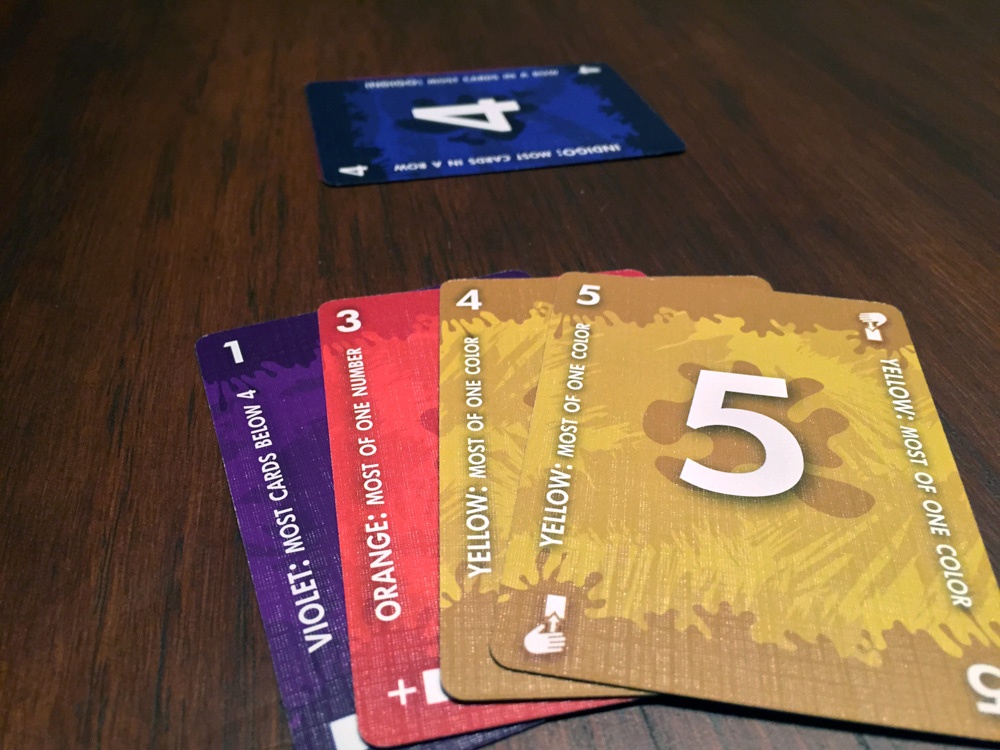
Game Experience:
So when I first heard about Red7, there were a lot of comparisons to Fluxx. This immediately turned me off the game because I absolutely hate Fluxx. If you put me on a desert island and the only game I had to entertain myself was Fluxx, I’d probably still use it to start a fire.
Anyway, I think one of the reasons Red7 gets this comparison is because the win condition of the game changes from turn to turn. After playing Red7, I can definitely say that the comparisons should end there. Red7 is actually a really good game that’s a lot of fun to play. It also ended up being a lot more of a strategic game then I expected.
When I first started playing Red7, it felt simple and I usually blamed the hand of cards I drew when I lost (which seemed to happen often). After a while though, I started to realize that there is a subtle strategy to Red7 that I was missing. I was playing the game to just win on my current turn and make it to the next. Survival. While that’s a fine goal, I really should have been trying to set myself up for future success.
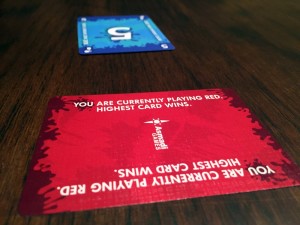
The cards you play in any given round are just as important later in rounds. You need to lay the ground work for future turns by building up your palette so that when you change a rule to make yourself winning, you have a strong palette that will be hard to beat. You start with 7 cards and those are the only cards you’ll ever get in a round (in the basic game). So planning your moves is important, but also keeping an eye on what your opponents are doing is important as well. You won’t be able to compete with everyone on everything.
If my opponent plays the red 7 card, then I know there is no point in ever changing the win condition to red (highest card). He has the top card in that set, so I need to alter my strategy and use those red cards for something else. If you can read your opponents and find out what they are strong in, you can help set yourself up to do better.
Ironically, this seems like a lot of strategy and depth for what is, for all intents and purposes, a filler game. Red7 takes about 5-10 minutes to play a full game, so it will never be the main course in your gaming night. But in the filler role, it excels. While it doesn’t have that strong theme or even sexy components, I constantly found myself being drawn back into it. It’s one of those games that you finish quickly, stare at the cards and say “lets play it again”.
One of the draw backs I quickly noticed with Red7 was that it really needs 3-4 players to be the most fun. As with many player elimination games (love letter comes to mind), having only two players feels like the game ends to quickly and doesn’t have the buildup of tension you’d want when your hand starts getting slimmer and slimmer. If you are primarily a gaming group of 2, then Red7 is probably not the game for you.
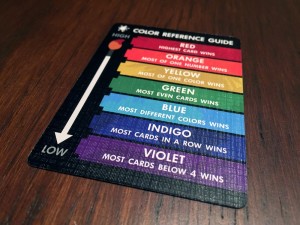
While Red7 does have some strategic elements to it, luck is still going to be a big part of the equation. From the cards you draw to what your opponents get in their hand, sometimes lady luck just won’t be on your side. This is even more so compounded by the fact that you don’t draw any new cards during the game. If you get a sub par hand to start the game, you just have to make the best of it. Fortunately, the next game is only about 5 minutes away.
One of the reasons Red7 makes such a great filler game is that the rules are so easy to learn. You can explain them in about 2 minutes and most people will understand right away. I’ve played this with family and friends both, and just about anyone can pick it up with no issues. While there are advanced rules, if you are looking for a longer or more complex game, then I’d say you are probably better off moving on to another game rather than trying to make Red7 any meatier than it is. I think it’s real charm lies in its simplicity and in the clever use of its cards. Which is probably why I stick with the basic game when we play. Filler games should be able to get to the table quickly and easily.
Final Thoughts:
If I could take a set of pruning shears to the internet, I’d find every statement of Red7 being likened next to Fluxx and delete it. There is really no comparison between these two. Red7 ended up being a lot of fun and a creative and clever card game that I really enjoyed. Carl’s design preferences really showed through as the 2 different ways each card can be used added a bit of depth to the hand management aspect of the game. Overall he did a great job creating a unique card game that’s accessible to just about anyone.
If you are looking for a quick little filler game then Red7 should absolutely be on your radar. For a price of under $15, there is not too many reasons not to give this one a try.
If you’d like to get yourself a copy of Red7, you can pick it up for $12
Edit 8/1/2015: While our review of Red7 as a game remains unchanged, due to our experience with Asmadi Games customer service, we do not recommend anyone buying this game (or any others of theirs). Please instead support publishers who appreciate their customers.
Final Score: 3.5 Stars – A fun little filler game that will provide some good entertainment in a quick game. Really needs at least 3-4 players for the most fun.
 Hits:
Hits:
• Quick playing and easy to learn
• Low cost
• Cards with multiple uses!
• Player elimination that’s OK
Misses:
• Not as much fun with only 2 players
• Rulebook could be better







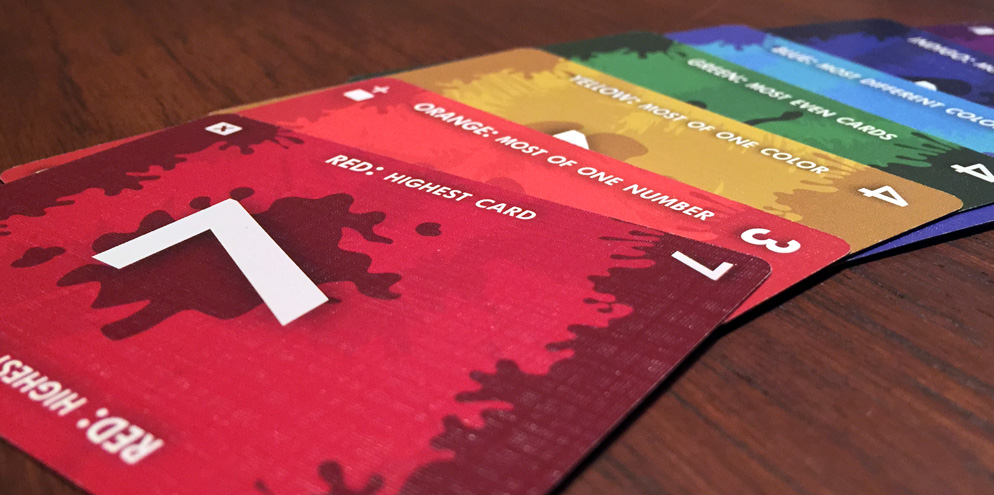














Nice game! Awesome Review!